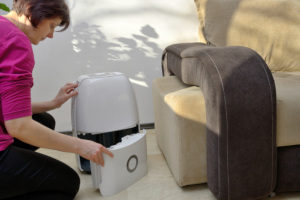Benefits of a basement dehumidifier

High humidity levels in the warm weather drive up the heat index. It makes you feel hotter than the temperature actually is. When the outdoor temperature is over 50˚F, the indoor humidity levels should be less than 50%.
High humidity levels in your home can make your air conditioner work harder, too. Your air conditioner cools your home by removing the moisture and heat from the air. The more moisture is in the air, the harder your system has to work to achieve a comfortable environment.
If you have a basement dehumidifier, it can significantly improve air quality throughout your home and reduce the potential for dampness and mold in the basement. A basement dehumidifier removes the moisture in the basement air. It also helps lower the humidity throughout your home by drying out the humidity that gets trapped in the corners and tiny spaces where air does not circulate as well.
A dehumidifier helps your air conditioner work more efficiently as well. When the air holds so much moisture that your air conditioner cannot remove it, your air conditioner will keep running but you will not get all of the cooling benefits from using it. However, you will pay more to cool your house without effectively cooling it, while putting unnecessary strain on your air conditioning system.
If you do not already have a dehumidifier, here are three signs that your air conditioner is not eliminating the humidity in the air inside your home:
- Your windows are fogged up. Foggy windows are a clear sign that your air conditioner is not removing the moisture in the air.
- You notice musty odors, especially in the basement. Moisture in the air can lead to mold and mildew growing in your home. It can cause unpleasant odors and can even become a safety hazard especially for those with allergies and respiratory disorders.
- The air feels clammy, especially in the basement. When you can feel the humidity indoors but you are still uncomfortable at cooler temperatures, and your air conditioner seems to run constantly, your air conditioner is likely being overwhelmed by the moisture levels.
What to do?
The best way to efficiently eliminate excessive indoor humidity in the warm weather months is to have a dehumidifier installed on your HVAC system. It will pull moisture and bacteria from the air before the air conditioner forces it through your air ducts. When you pair a dehumidifier with an air conditioning system, you can easily adjust the temperature and humidity level of your home.
A money-saving alternative to an HVAC dehumidifier is a portable dehumidifier. It will not provide the same convenience and performance level but it will help to dehumidify your basement.
The best setting for your dehumidifier
The ability to control the humidity levels is important because the most comfortable setting in the summer season will not be a comfortable setting in the winter months. The best setting depends on the outdoor temperature. When the outdoor temperature is over 50˚F, the indoor humidity levels should be less than 50%, as already stated. However, when the temperatures drop below 50 degrees, the indoor humidity levels should be closer to 40% and even lower with colder outdoor temperatures.
How you can achieve these ideal humidity levels depends on the following considerations:
Outdoor temperature and humidity levels
In high humidity areas of the country, a dehumidifier is important to healthy indoor air quality.
Size of the space
The more space you are trying to dehumidify, the bigger the dehumidifier you will need. If you get a dehumidifier that is too small, you will not achieve the desired comfort levels efficiently, if at all.
Determine the square footage of the room (or rooms) where you will be using the dehumidifier to know what size dehumidifier to purchase. A larger dehumidifier is able to remove more moisture from the air.
Nature of the basement construction
A basement that is fully below ground level with no walk out and limited ventilation is likely to have a higher volume of trapped humidity than one that is partially above ground or is a walk-out. Additionally, the basement of an older home that is not waterproofed to current codes will likely feel damp and even feels and smells wet in the summer months. You may have observed mold growth, too. These basements will need a larger dehumidifier than a drier basement of the same square footage.
The Association of Home Appliance Manufacturers has guidelines on the right size dehumidifier. A 30-pint dehumidifier is appropriate for a moderately damp area up to 2000 square feet in size. However, the same size dehumidifier in an area where some moisture on the walls or moisture seepage is visible is suitable only for a space up to 1500 square feet. A larger area or an area with significant mold growth will require larger sizes.
Mold prevention
To prevent the growth of mold, the humidity in your home must stay below 50 percent humidity.
Choose a good dehumidifier
You should find a dehumidifier that has an automatic on/off feature. It will turn itself off automatically when the humidity in the room drops below the amount you selected and turn back on automatically when the humidity level starts to rise. This will keep the humidity in your home constant at the level you selected while saving you on your electric bill. Also, find one that has an easy-to-operate humidity setting control. The controls should be easy to reach and user-friendly.
Contact an experienced HVAC contractor for more information
Before you buy a dehumidifier, make sure you are getting the one that is best suited for your home and your budget. If you already have a dehumidifier and are wondering if it is operating at optimal performance levels, you may need to have it evaluated. Speak to an expert HVAC contractor for more information on dehumidifiers and how they can make your home more comfortable.

